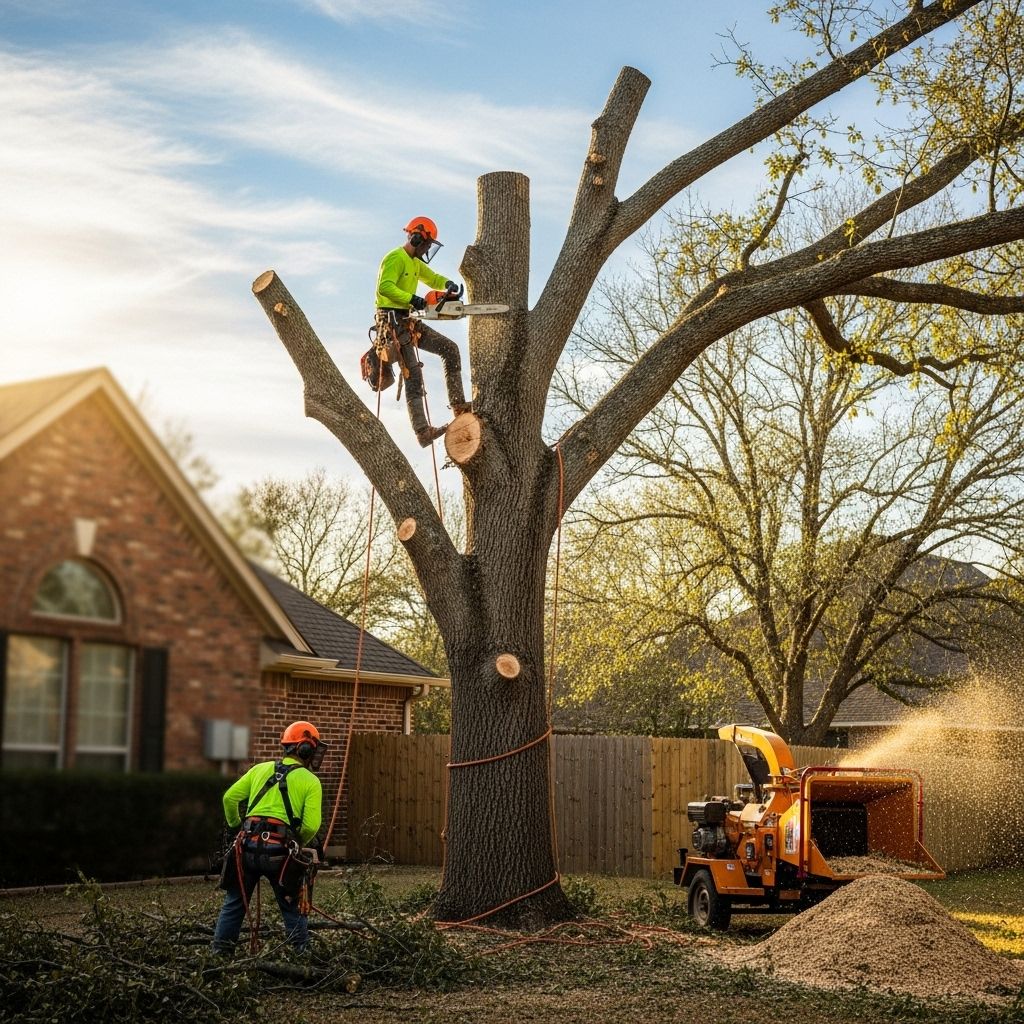Tree Removal Cost In 2024: Averages, Ranges & 5 Key Factors
Discover budget-friendly solutions and expert tips to clear your space safely this year!

Image: HearthJunction Design Team
Average Cost of Tree Removal in 2024
Tree removal is an essential service for homeowners who need to address hazardous, dead, or unwanted trees in their landscape. The cost of removing a tree varies widely, depending on a range of factors such as the tree’s size, type, condition, and accessibility. This 2024 guide will help you understand what to expect when budgeting for tree removal and what factors impact the total price.
How Much Does Tree Removal Cost?
On average, homeowners pay $657 for professional tree removal services. However, the total cost can range from as low as $341 to as high as $1,523 per tree. Some removals, especially for very large or hazardous trees, can exceed this range, while smaller or easier jobs may fall below it.
- National Average: $657 per tree
- Typical Range: $341 to $1,523 per tree
- Low End (Small, accessible trees): $200–$500
- High End (Large, hazardous, difficult to access): $2,000 or more
Understanding the factors that influence these prices is key to getting the best value for your tree removal needs.
Factors Influencing Tree Removal Cost
Several elements determine the price charged for tree removal. Here are the main contributors:
- Tree Height and Size: Taller, thicker trees require more labor, specialized equipment, and time to remove, resulting in higher costs.
- Tree Species: Hardwoods like oak or hickory are heavier and harder to process than softer woods, raising removal costs.
- Location and Accessibility: Trees close to structures, power lines, or difficult terrain cost more to remove due to increased risk and logistical challenges.
- Tree Condition: Dead, diseased, or decaying trees may be unstable and require extra caution, leading to higher prices.
- Emergency or Hazard Removal: If a tree is dangerous or needs immediate removal due to storms or emergencies, expect a premium charge.
Typical Cost Breakdown by Tree Size
| Tree Size | Description | Cost Range (USD) |
|---|---|---|
| Under 30 feet | Small trees | $500 – $1,000 |
| 30–60 feet | Medium trees | $800 – $1,200 |
| Over 60 feet | Large trees | $1,200 – $3,000+ |
These costs may increase if the tree is near structures or requires complex rigging for a safe removal. Proximity to utility lines, for example, typically adds $100–$300 to the base cost.
Additional Factors That Affect Tree Removal Cost
- Trunk Diameter: Thicker trunks are more challenging to cut and haul.
- Fallen vs. Standing Trees: Removing already downed trees is typically less expensive.
- Number of Trees: Removing multiple trees in one visit may reduce the per-tree price.
- Travel Fees: Remote or hard-to-access locations may incur additional transportation charges.
Cost of Related Services
Tree removal often involves more than just cutting down a tree. Here are some common additional services—and their average price ranges—you may need to factor into your budget:
- Stump Removal: $75–$500 per stump on average, or $2–$5 per diameter inch. This is a separate service from tree removal and not always included in the base price.
- Stump Grinding: Usually cheaper than full stump removal, ranging from $100–$400 depending on stump size and complexity.
- Branch or Limb Removal: If only hazardous limbs need removal, expect to pay $75–$450 per limb, depending on size and height.
- Log Splitting or Chipping: Turning the removed wood into firewood or mulch may be available for an extra charge—typically $50–$150 per load.
- Cleanup and Haul-Away: Full debris removal can add $50–$200+ based on the amount and type of material.
Stump Removal Cost Table
| Stump Diameter | Typical Cost |
|---|---|
| Up to 12” | $30–$60 |
| 24” | $48–$120 |
| 36” | $72–$180 |
| 48” | $92–$240 |
| 60” | $120–$300 |
| 72” | $144–$360 |
Keep in mind, some companies have a minimum fee (often $75–$100) for stump removal jobs.
DIY vs. Professional Tree Removal
While tree removal may seem like a potential DIY project, it is not recommended for most homeowners. Cutting down trees, especially large or hazardous ones, is dangerous and requires specialized skills and equipment. Professionals are insured and trained to handle unforeseen complications, such as unpredictable falls or working near power lines.
- For safety and liability reasons, hire a licensed tree removal service for any job involving large trees or proximity to structures.
When Should a Tree Be Removed?
Consider removing a tree if you notice:
- Signs of disease or decay, such as mushroom growth, hollow trunks, or excessive dead branches
- Physical damage from storms or construction
- Trees leaning dangerously toward structures or power lines
- Root systems causing structural damage to foundations, sidewalks, or driveways
- Obstruction of sunlight or undesired mess (heavy leaf or fruit drop)
Consulting an arborist before removal is wise, as they can identify if pruning or treatment is a better solution.
How to Save on Tree Removal Costs
- Get Multiple Quotes: Contact at least three tree removal companies to compare prices and services.
- Off-Season Removal: Scheduling removal in the winter or early spring may result in lower prices due to reduced demand.
- Bundle Services: Removing multiple trees or adding stump grinding could qualify you for a package discount.
- Handle Debris Yourself: You can save by handling wood and debris removal on your own, if permitted.
Tree Removal Cost Examples
Let’s look at a few common scenarios to give you a better sense of what tree removal might cost:
- Small Ornamental Tree (20 feet, easy access): $300–$500
- Medium Maple (40 feet, near house): $800–$1,000
- Large Oak (70 feet, close to power lines): $1,500–$2,500+
- Hazardous/Storm-Damaged Tree: Add $500–$1,000 to the base rate, depending on complexity
How to Choose a Tree Removal Company
- Verify Credentials: Ensure the company is licensed, insured, and certified by relevant organizations (such as the International Society of Arboriculture).
- Check Reviews: Read customer reviews and request references from past clients.
- Request a Written Estimate: Get detailed, itemized estimates that clearly outline all included and extra costs.
- Understand Services: Confirm whether the quote includes stump grinding, debris cleanup, and hauling away logs or limbs.
Frequently Asked Questions (FAQs)
How long does tree removal take?
The time needed depends on the size and complexity of the tree. Most removals take 2–4 hours, but larger or more complex jobs may require a full day or more.
Does homeowners insurance cover tree removal?
Insurance may cover tree removal if the tree falls due to a covered peril (like windstorm) and causes damage. Routine removal of dead or diseased trees is typically not covered.
Is stump removal included with tree removal?
No. Stump removal or grinding is usually a separate service and is not included in standard tree removal quotes.
What’s the difference between stump removal and grinding?
Stump removal extracts the entire stump and roots, while stump grinding shreds the stump below ground level but leaves roots behind. Grinding is less invasive and typically cheaper.
Can I reduce tree removal costs by keeping the wood?
Yes. Some companies may reduce your fee if you keep the wood for firewood or mulch and opt out of full cleanup and haul-away services.
Conclusion
Tree removal costs in 2024 typically range from $341 to $1,523 per tree, with an average around $657. Your price will depend on tree size, location, condition, and optional services like stump removal. Always consult professionals to ensure safety and quality, and compare quotes to get the best deal. For additional savings, schedule in the offseason, bundle services, or handle wood and debris on your own, if possible.
References
- https://www.thisoldhouse.com/gardening/reviews/average-cost-of-tree-removal-toh-hghb
- https://www.thisoldhouse.com/gardening/reviews/stump-removal-cost
- https://www.youtube.com/watch?v=LkZe8A5h7Os
- https://www.thisoldhouse.com/landscaping/21015927/how-to-remove-a-dangerous-tree
- https://renstromtreeservice.com/2023/06/29/understanding-the-cost-of-tree-removal/
Read full bio of Srija Burman










